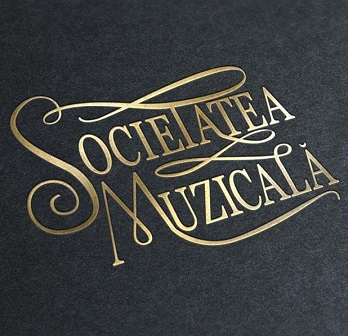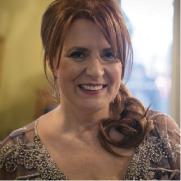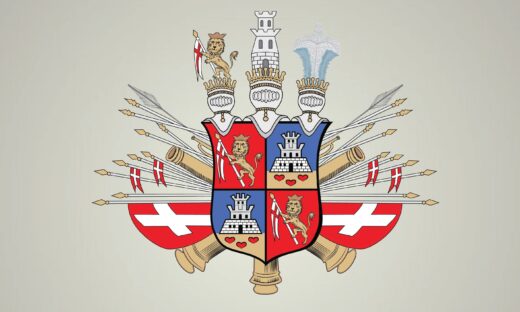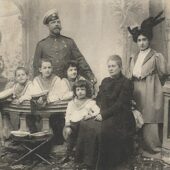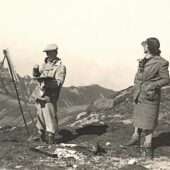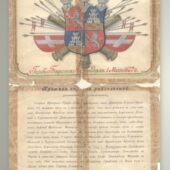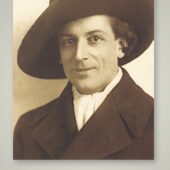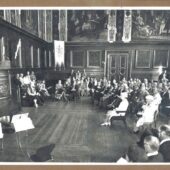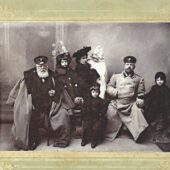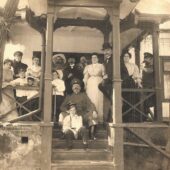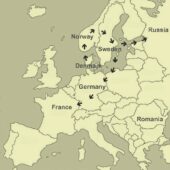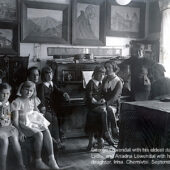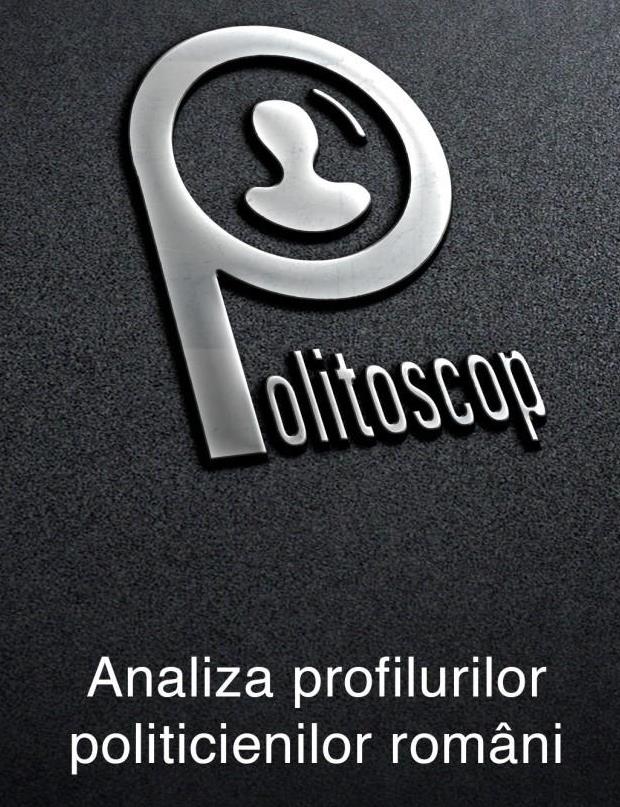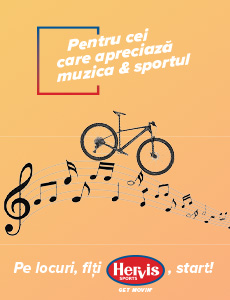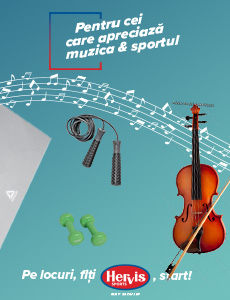Ariadna Löwendal-Dănilă was born in Bucharest on January 2nd 1964. Her mother, actress Irina Dall, is one of the two daughters of George baron Löwendal – painter, scenographer, and founding member of the Romanian Union of Artists. Isolated and eventually almost exiled from the country’s artistic life, on account of his aristocratic origins, George baron Löwendal, an artist blessed with so many talents, including an extraordinary capacity to create and channel energies, continued to live just as intensely even after his death, throughout the stories of his two daughters. They understood that keeping his legacy from slipping into oblivion is very important. It is in this very spiritual family environment that Ariadna spent her childhood, feeding herself on fabulous stories about her grandfather.
Growing up with the few paintings that were left in the house as well as with other important documents, scenography and costumes blueprints, notes about shows, events, and people, Ariadna Löwendal-Dănilă gradually learnt to understand the value of all these objects. At the same time, she acknowledged that she wanted to bring to light a cultural treasure as this, which was out of the question during the communist era and remained a very difficult to do even after the Revolution in December 1989.
While being a valuable scientific researcher and running a succesful pharmaceutical business, Ariadna Löwendal-Dănilă succeeds in translating the dream of her family that she’s the sole representative of. She managed to create The Löwendal Foundation. Placing it in an amazing building, she provided it with an effervescent life, with rich evocative and challenging programs, searching for and gathering proofs from across the country and around the world that would complete the image of an artistic character that was exceptionally complex.
The main objective of this foundation is reinstalling George baron Löwendal’s work in the evolution of Romanian and European art during the first half of the 20th century. “I bought the house, had it arranged and turned into the Löwendal Foundation, which takes the name of my family. It was founded in 2010 for the popularization of my grandfather’s work, George baron Löwendal. My mother and her sister had wanted to do this for a long time. They waited for the authorities to give them a memorial house that would shelter my grandfather’s art collection, but time passed by in vain. I was lucky enough to have the financial resources for that,” Ariadna continued.
At the same time, the artist’s niece bought a domain near Urziceni that she will include in Löwendal’s heritage. Ariadna Löwendal-Dănilă is the owner of Manasia Domain and is currently having the location restored so that it can host cultural events.
„The neo-Romanian style villa, near Ioanid Park, in the heart of Bucharest, seemed to me the ideal place for the cultural foundation that I created in 2010. From then on, all of my projects were linked together and naturally acquired their own life”.
Ariadna Löwendal-Dănilă, president of Löwendal Foundation, daugther of actress Irina Dall (Löwendal).
Ioanid Park division
The Löwendal Foundation building is part of the urban plan for Ioanid Park. The Ioanid Park division into lots was designed in 1909 -1910 by the Technical Department of the Bucharest City Council, inspired by the Parc Monceau in Paris. The Ioanid Park is still built on a different scale but it takes up the idea of dividing the lots of land around the park.
Löwendal Foundation
The Löwendal Foundation proposes to promote the oeuvre of George Löwendal, as well as the support and encouragement of contemporary art. Situated in Bucharest, in the immediate vicinity of the Ioanid Park and the Icon Garden Park, Löwendal House hosts the projects of the Foundation of the same name, opened in 2010.
The Löwendal Foundation is dedicated to the promotion of the work of painter and scenographer George Löwendal, an important figure in the Romanian inter-war and post-war art world, and the production and organization of curatorial, editorial and educational projects in the visual and performing arts.
Löwendal House is emblematic of the Neo-Romanian architectural style. The creation of architect Petre Antonescu, the building stands out for its elegance, its refined asymmetrical volumes and the vertical accent of the tower on the main façade.
The galleries with trilobed or semi-circular arches call to mind towers and traditional houses. Built at the beginning of the 20th Century, the building even today retains the discreet, aristocratic charm of that era. The interior decoration borrows some Neo-Romanian elements and harmoniously integrates them into eclectic compositions. The rooms with wooden ornaments, wall panelling and coffered wood, the elaborate stucco and the braided belt model, which recur as a unifying element throughout the entire house, give the interior space a refined and yet friendly atmosphere. Building with two levels, has a total area of 225 square metres.
The museum includes an art collection of more than 500 works of oil painting, graphics, set design blueprints, memoirs, and stories of George baron Löwendal about his paintings. Like the artist’s niece says, “it is an impressive archive for Romania.” Beginning in 2010, together with the launching of the Löwendal Foundation, the building has hosted cultural projects of its own and realised in partnership with various public and private institutions (exhibitions, conferences, book launches, art contests, etc.)
International Exhibitions
- 2007 – Romanian Cultural Institute in Vienna, Austria
- 2011 – Romanian Cultural Institute in Prague and Quadrennial of architecture and scenography in Prague, Czech Republic
- 2011 – Romanian Cultural Institute in Paris and Béhague Palace, France
- 2013 – Art Museum, Chernivtsi, Ukraine
- 2017 – Romanian Cultural Institute in Berlin, Germany
- 2018 – Art Museum, Kishinev, Republic of Moldova
The George Löwendal National Scenography Competition
The Löwendal Foundation is the organizer of the George Löwendal National Scenography Competition, a unique project in Romania and an exclusive brand of the Löwendal Foundation.
- 2010 Theme: The Night Asylum by Maxim Gorki
- 2011 Theme: Marriage by Nicolai Gogol
- 2012 Theme: Volpone by Ben Jonson
- 2013 Theme: Hamlet by William Shakespeare
GEORGE BARON LÖWENDAL – painter and scenographer (1897-1964)
The family Blazon
Ulrik Frederik Gyldenløve, son of Frederick III King of Denmark, was married to Sofia von Urne. In 1660 they had a son – Woldemar Baron de Löwendal, who was Active Intimate Advisor and President of the Polish Royal Chamber and Kingdom of Saxony, hereditary owner of Mückenberg estate in Meissen, General in chief, Grand Marshal of the Court, Intimate Minister of Cabinet and Knight of the Order of the Polish Eagle and the Order of the Danish White Elephant.
He died in 1740. With his wife Dorothea von Brockdorf of Holstein, they had two son: Ulrik Frederik Baron de Löwendal, Chambelain Royal Poles and the Electorate of Saxony and Woldemar Count of Löwendal; appointed General Royal Pole in 1734. He entered service Russian military as Chief General, Imperial Count, Governor of Estonia and knight of several orders. On his death in 1755 he was Marshal in France. He graduated from Imperial Count June 18, 1740.
Follows the family of Baron Löwendal.
Frederic III
King of Denmark and Norway (1609-1670)
Ulrik Frederik Gyldenløve
Viceroy of Norway (1638-1704)
Woldemar Count of Löwendal (1700-1755)
Grand father paternal, Nicolai (II) baron Löwendal (1842-1898)
General Major of the Russian Admiralty in St. Petersburg
George Löwendal, painter and scenographer, from St. Petersburg in Bucharest
Biographical references, 1897–1964
1897
George Löwendal is born on 10th May, 1897, in St. Petersburg, first of four sons of Laurence II baron Löwendal, officer in the Tsar’s Army. According to the scarce genealogical information included in the family blazon, the Löwendal barons were descendents of Ulrik Frederick Gyldenl.ve, born in 1638, son of King Frederic III of Denmark and Norway. George’s mother, Liubov Gavrichova, is the daughter of Lev Osipovici Gavrichov, hero officer of the Russian Black Sea Fleet. The Löwendal couple will still have three boys: Lev, Nikolai and Boris.
1914-1917
George Löwendal completes high school lessons in Kiev. Then, he went to St. Petersburg (Petrograd) for fine art lessons, including those of the painter Saveli Moiseevici Zeidenberg. His mentors are the peredvijnitchi (itinerant painters) Aleksandr Vladimirovici Makovski and Aleksandr Petrovici Aleksandrov. From time to time he worked as an actor, dancer, painter and decorator, and in 1915 as a scenographer at the Opera Theater of Prince Oldenburg.
1918-1921
The artist’s father, Laurence (II) baron Löwendal is said to have died in action to save the family from Tsar Nicolai II (who was to be executed in summer 1918). In the same period, his mother, Liubov Gavrichova, is deported to Uzbekistan.
George follows his mentor, the professor Aleksandrov, in Bessarabia. In Soroca he discovered his passion for animation theater: he made dolls, writes plays with Ariadna Ambrozieva, her fiancée, and stages shows for children. In Kishinev, he collaborates with various theatre companies as painter set designer; he creates sets with patterns inspired by Russian folklore (lubok) .It also makes decorative panels for the Pavilion of the Assembly of Nobility.
1921
He married in Kishinev with Ariadna Ambrozieva, from Toula (Russia), a student at the Odessa Faculty of Law. Poet, writer, soloist-concertist and, later, professor of foreign languages and canto, she will be all lives a support for him, being at the same time his critic and a wise adviser.
1921-1925
The new family settles in Bucharest where the artist is learning the Romanian language. He works as a set painter and director at a few summer gardens and review theaters: Cărăbuș, Grădina Blanduziei, ”Carol cel Mare” (Eforie).
He is asked to work with important representatives of the interwar scene: at the “Regina Maria” Theater (Company “Bulandra”) and at the Central Theater, where there was the famous Vilnius troupe, established for a few seasons in Bucharest – it collaborates mainly with the director Iacob Sternberg, a follower of the “Synthetic theater,” author of anthological experimental montages.
On October 28, 1923, his first daughter was born, Lydia (d. 2006). On June 13, 1925, his second daughter was born, Irina (d. 1995).
1926-1935
Participation in the first collective exhibition of interwar scenography – organized by art critic Ștefan Neniţescu at the Hasefer Bookstore in Bucharest – made him one of the most valuable Romanian decorative painters. Next to L.wendal, exhibit works by Theodor Kiriacoff-Suruceanu, Marcel Iancu, M.H. Maxy and others.
He accepted a job as a set painter and technical director at the National Theater in Chernivtsi (at the time, the youngest subsidized company in the country). He left the Capital and, with his family, settled in the cosmopolitan city of Bukovina.
During the same period, other important artists of his generation worked there: Victor Ion Popa (appointed artistic director of the institution), Aurel Ion Maican, George Mihail Zamfirescu – animators of the theatrical life of the interwar period with whom he shares the same innovative vision of the performing arts.
Thanks to his collaboration with them, Chernivtsi’s stage is propelled into the vanguard of the Romanian theatrical movement.
He makes an unprecedented montage for the room Crime and Punishment, adaptation according to Dostoevsky, which offers technical innovation – sliding rail scene.
He played a decisive role in the creation of the first puppet and puppet theater in Romania, inaugurated as a section of the Chernivtsi National Theater on May 1, 1928; for the cut show presented on this occasion – The Theater Director and Bastien and Bastienne, comic operas in an act by W.A. Mozart -, he creates dolls, costumes, sets, as well as the painted curtain of the small animation theater.
In the 1927–1928 season, he made the sets for R.U.R. by Karel Čapek, the first Romanian montage of a SF play and builds the country’s first revolving stage. In parallel, he does easel painting. These are mostly farmers and the monasteries of Bukovina which attract him and become the preferred and characteristic motif of his plastic creation.
1931-1933
In 1931 he founded the Society of Plastic Artists of Bukovina, called “The Friends of Art”.
1934
He achieved triumphant success in Timișoara with the operetta sets The Land of Smiles by Franz Lehar. As a tribute, the city authorities offer him one of the bullets preserved in the Banat History Museum – a testament to the participation of his ancestor, Ulrich Frederick Woldemar Count of Löwendal, in the liberation of Timișoara from Turkish occupation (1716).
1935-1940
September – October 1935: The first major solo exhibition at the Mozart Hall in Bucharest (oils, drawings, watercolors). The specialist critic consecrates him as a leading representative of Romanian plastic art.
In 1936, Leo van Puyvelde, president of the International Committee for the History of Art, acquired from him the painting The Peasant with the broken Hat (1935) for the Museum of Modern Art in Brussels.
In 1937 he stayed permanently in Bucharest with his family. He participates with graphic works (posters) in all the exhibitions of the National Tourist Office of the country and abroad.
1942-1945
For a short time, George Löwendal collaborates as a set designer with the Craiova National Theater. In 1943 he painted in Bukovina and then opens a highly successful exhibition hosted by the Universul Hall in Bucharest. All 80 paintings on display were sold.
1945-1946
He contributed by donating models and sketches, at the creation of the Țăndărică Theater from Bucharest, the first professional puppets theatre in Romania. He organized – an unprecedented event for the cultural landscape of the time – a painting exhibition in the Ghelari mine, Hunedoara county.
1947-1948
In 1947 Mihai I, King of Romania conferred on him the Order of „Cultural Merit” as an officer.
1950-1957
It is a period during which he works as a university professor at the “Nicolae Grigorescu” Institute of Visual Arts in Bucharest. Among his students: Sabin Bălașa, painter, Dorana Coșoveanu, art historian and critic, Dan Nemțeanu, scenographer, Nae Săftoiou, illustrator, Leontina Mailatescu, painter, Ariana Nicodim, painter, Sanda Nițescu, painter and writer. During the summer of 1954, he gave open lessons for his students in the medieval city of Sighişoara.
On November 11, 1954, his wife died. In subsequent years, the artist will be preoccupied with the writing of Ariadna Löwendal’s literary creation, as well as his own writings. In periodicals of the time, he published some autobiographical stories. From August 1955, he signed his works of plastic art GLA (by adding to his own initials the letter A of the first name of his wife).
1957-1964
Every summer, he paints numerous landscapes and portraits of peasants in Bukovina.
1964
On January 2, her granddaughter Ariadna, Irina’s daughter, was born in Bucharest.
February 18, 1964
George Löwendal suddenly dies. He is buried in the „Sfânta Vineri” Cemetery in Bucharest.
